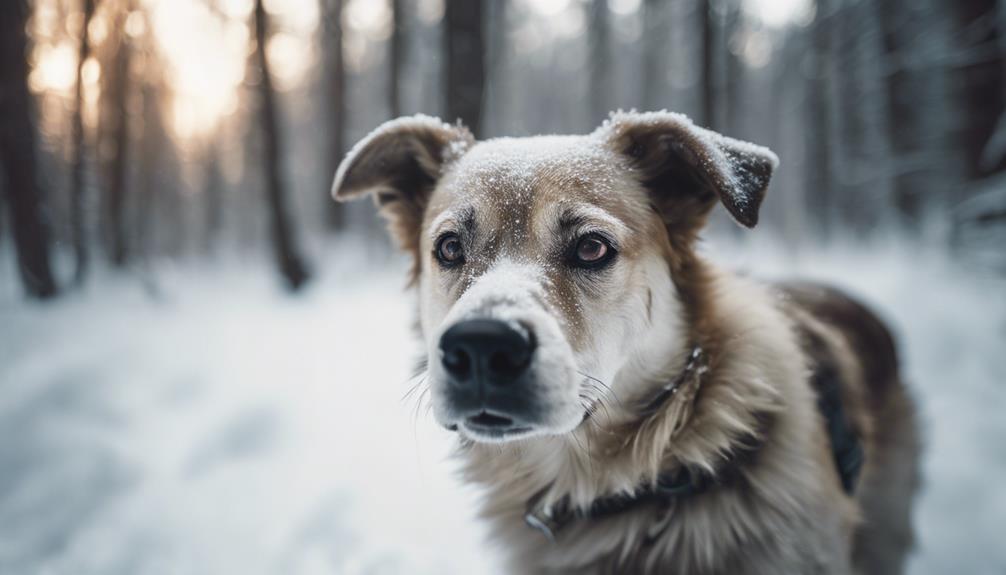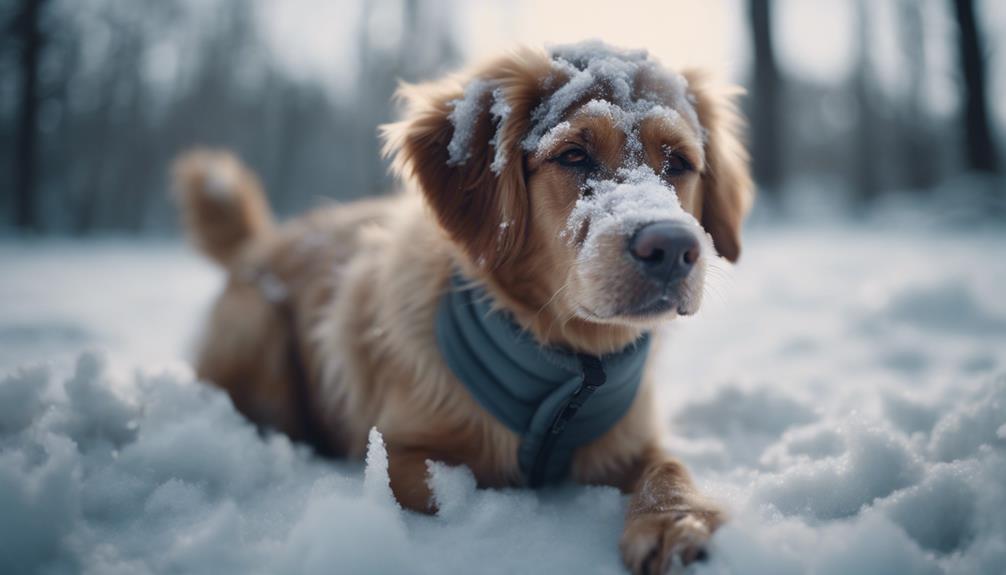As temperatures drop and winter approaches, dog owners need to be vigilant in recognizing the dangerous signs of hypothermia in their beloved pets. While some symptoms may be subtle, the consequences of overlooking them can be severe.
From mild shivering to more pronounced signs of lethargy and cold extremities, understanding these early indicators is crucial for prompt intervention. By exploring the nuances of hypothermia in dogs, we uncover essential insights that can potentially save lives.
Stay tuned to discover the key factors that every pet owner should be aware of when it comes to identifying and addressing this silent threat to canine health.
Key Takeaways
- Early signs include shivering, whining, and curling up.
- Severe cases exhibit pale gums, cold extremities, and unresponsiveness.
- Immediate warmth, dryness, and monitoring are vital in treatment.
- Prevention involves limiting cold exposure, monitoring, and seeking veterinary help promptly.
Causes and Risk Factors of Hypothermia
Exposure to cold weather, wind, rain, or snow is a primary cause of hypothermia in dogs, with wet conditions further accelerating heat loss in these animals. Factors such as size, health, age, breed, and fur condition also play a role in their temperature tolerance.
Even in warm weather, activities like swimming can lead to hypothermia. Underlying health issues coupled with cold weather exposure increase the risk significantly.
It is important to consider these causes and risk factors to prevent the onset of hypothermia in dogs. By understanding these triggers, pet owners can take appropriate precautions to safeguard their dogs from this potentially life-threatening condition.
Signs and Symptoms of Hypothermia
Frequently characterized by initial signs such as shivering, whining, and fussing, hypothermia in dogs manifests through a range of observable symptoms. As hypothermia progresses, dogs may curl up and become quiet. Signs of severe hypothermia include pale gums, cold extremities like feet, tails, and ears, along with unresponsiveness, dilated pupils, slowed heart rate, weakness, sluggishness, cold skin, and muscle stiffness.
These symptoms indicate a critical need for immediate attention and veterinary care. Recognizing these signs promptly is crucial in preventing further complications and ensuring the dog's well-being. Monitoring the dog's behavior and physical condition in cold weather or after exposure to water activities is essential to catch hypothermia early and provide timely intervention.
Treatment and After Effects of Hypothermia

As hypothermia in dogs can lead to severe consequences, prompt and appropriate treatment is essential to mitigate potential after effects and ensure the dog's recovery. Immediate care involves moving the dog to a warm, dry place and towel drying while wrapping in a warm blanket. Mild cases can often be managed at home, but moderate to severe cases necessitate veterinary intervention. These more severe instances may result in organ damage, requiring close monitoring and potential bloodwork. Veterinary treatment may encompass various warming techniques, IV fluids, and oxygen therapy.
- Move the dog to a warm, dry location.
- Towel dry and wrap the dog in a warm blanket.
- Moderate to severe cases may require veterinary care.
- Treatment may involve warming techniques, IV fluids, and oxygen therapy.
Prevention and Early Detection
To effectively safeguard dogs from hypothermia, proactive measures must be implemented to prevent and promptly identify early signs of this potentially life-threatening condition. Limiting outdoor time in cold, wet weather, and providing shelter from wind and wet conditions are essential preventive steps.
Using jackets or coats can help protect dogs from the cold, while monitoring body temperature and promptly drying off wet dogs can aid in early detection. Consulting a veterinarian for safe temperature ranges and regularly checking for signs of hypothermia, especially in winter, are crucial.
Early detection is key, as rapid treatment is necessary to prevent fatal outcomes. Acting promptly upon observing symptoms can significantly improve the chances of a positive outcome for the affected dog.
Importance of Preventing Hypothermia

Implementing proactive measures to prevent hypothermia in dogs is crucial for ensuring their well-being and overall health. Hypothermia can have serious consequences if not addressed promptly. To effectively prevent hypothermia in dogs, consider the following key points:
- Provide adequate shelter from cold, wet conditions.
- Use jackets or coats to protect dogs from low temperatures.
- Monitor body temperature regularly and dry off wet dogs promptly.
- Consult a veterinarian for guidance on safe temperature ranges and early detection of hypothermia symptoms.
Immediate Veterinary Care
Prompt veterinary intervention is essential for addressing hypothermia in dogs effectively and preventing potential long-term complications.
In cases of moderate to severe hypothermia, professional veterinary care is crucial. Veterinarians may employ warming techniques, administer IV fluids, and provide oxygen therapy to stabilize the dog's condition.
Organ damage from hypothermia necessitates close monitoring and potential bloodwork to assess the extent of internal harm.
Delayed treatment can lead to fatal outcomes, underscoring the importance of seeking immediate veterinary care when hypothermia is suspected.
Proper and timely intervention not only improves the dog's chances of recovery but also minimizes the risk of lasting repercussions from severe hypothermia episodes.
Proper Warming Techniques

Utilizing appropriate warming techniques is vital in effectively addressing hypothermia in dogs and aiding in their recovery process. To warm a dog safely and efficiently, consider the following techniques:
- Gradual Warming: Avoid direct heat sources to prevent burns and shock.
- Warm Blankets: Wrap the dog in dry, warm blankets to help raise their body temperature.
- Hot Water Bottles: Place warm water bottles wrapped in towels near the dog to provide additional warmth.
- Body Contact: Use your body heat by snuggling with the dog to help increase their temperature steadily.
Fatal Risks of Untreated Hypothermia
Neglecting to address hypothermia in dogs promptly can lead to severe consequences, including potential fatality due to the body's inability to maintain a healthy temperature balance. Untreated hypothermia can result in organ failure, cardiac arrest, and ultimately death. Here is a table summarizing the fatal risks of untreated hypothermia in dogs:
| Fatal Risks of Untreated Hypothermia |
|---|
| Organ Failure |
| Cardiac Arrest |
| Death |
Key Preventive Measures

To safeguard dogs from the risks associated with hypothermia, implementing key preventive measures is essential in maintaining their well-being and health.
- Provide adequate shelter from cold, wind, and wet conditions.
- Use jackets or coats to protect dogs from low temperatures.
- Regularly monitor body temperature and dry off wet dogs promptly.
- Seek veterinary advice to establish safe temperature ranges and for early detection of hypothermia symptoms.
Conclusion
In conclusion, understanding the causes, risk factors, symptoms, treatment options, and preventive measures of hypothermia in dogs is crucial for responsible pet ownership.
By being vigilant and proactive in recognizing the dangerous signs of hypothermia, dog owners can ensure the well-being and health of their furry companions.
Early detection, proper warming techniques, and immediate veterinary care are essential in preventing the fatal risks associated with untreated hypothermia.
Prevention is key in safeguarding dogs against this potentially life-threatening condition.




